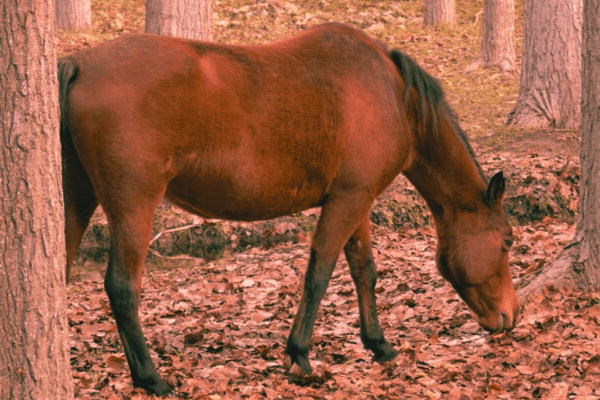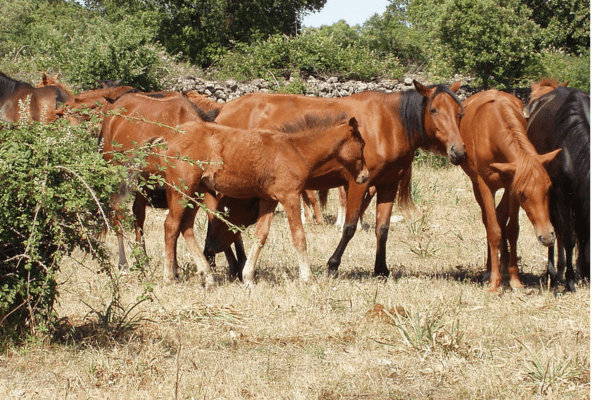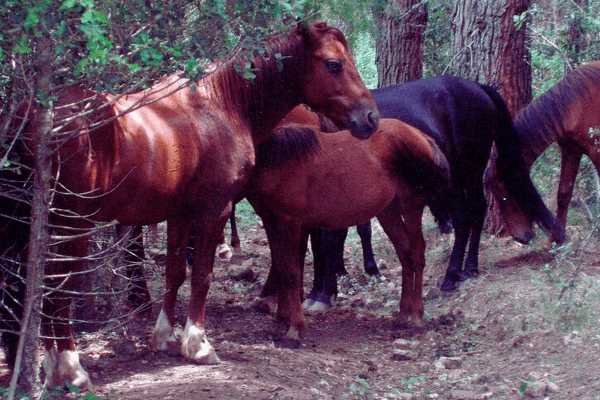The Sarcidano breed, a distinguished and rare variety of horse, emerges from the serene highlands of the Sarcidano Plateau, nestled in the commune of Laconi on the enchanting island of Sardinia, Italy. This breed, renowned for its semi-wild characteristics, is a testament to the rich equine diversity of the Mediterranean region.
Esteemed as one of the fifteen indigenous horse breeds of limited distribution, the Sarcidano is formally recognized by the Italian Horse Breeders Association (AIA). This acknowledgment not only celebrates its rarity but also underscores the breed’s significant role in the cultural and biological heritage of Italy’s equine population.
History:
Tracing the roots of the Sarcidano horse reveals a complex web of history and genetics connecting this rare breed with those found throughout Spain’s past. Echoing Andalusian horses’ royal bearing, its lineage bears witness to centuries of evolution and cultural exchange throughout Europe and North Africa.
Historical Genetics and Ancestry
Studies on Spanish Ancestry Linkage: Studies undertaken during the late 20th century, such as those by Valiati (1997) and Bell (1999), focused on transferrin markers found within this breed, revealing its genetic relationship to Iberian horses of 16th century Spain.
Polymorphism Studies: In 1996, an important research effort explored polymorphism of protease inhibitors to further support historical accounts suggesting the Sarcidano breed might have links with ancient Spanish horses through genetic inheritance; such a claim is further supported by historical documents pertaining to Sardinian horse breeding practices.
Unique Physical Traits
One unique physical trait of the Sarcidano horse is its constant presence of a seventh molar in its upper jaw. This trait is only shared among ancient breeds like Exmoor Pony and Caspian Horse indicating a deep evolutionary pathway.
Genetic Rarity: Underscoring its unique heritage, the Sarcidano horse displays an allele typically found in Przewalski’s Horse breed of wild horses – suggesting a vast and complex genetic heritage.
Conservation and Population Growth
Initiatives in Laconi: In 1999, Laconi took an important step towards conservation by purchasing 15 Sarcidano horses from private owners for relocation into Funtanamela Forest on the Sarcidano Plateau.
Population Expansion: Over time, this initial group grew into an herd numbering about 100 by 2006. Two other herds contributed to the breed’s population as well: one owned privately in Ozieri in central northern Sardinia and the other managed by Istituto di Incremento Ippico della Sardegna (IIIS) located nearby.
2007 Population Statistics: By 2007, approximately 190 Sarcidano horses existed, of which 78 were mares – evidence of their steady but hopeful increase.
Formal Recognizance and Preservation
Official Recognition: On 5 November 2003, our journey towards official recognition came to fruition when Ministerial Decree No. 24347 was signed into effect – marking the formal acknowledgment of the Sarcidano as an independent breed.
Establishment of the Stud-Book: Following this recognition, 2005 saw the establishment of a Stud Book to record and preserve its lineage. This record is maintained by Associazione Provinciale Allevatori di Nuoro to facilitate structured breeding efforts as well as conservation.

Characteristics:
The Sarcidano horse breed, steeped in Italy’s heritage and distinguished by a range of special characteristics that showcase its adaptability and resilience, conforms to an established standard that highlights their specific physical traits and temperament traits.
Physical Appearance and Coat Color
Coat Color Variations: The Sarcidano horse typically exhibits three coat colors: black, bay or grey. These colors are representative of its breed identity and registration for any other colors is prohibited in order to maintain purity and distinctiveness of this breed.
Size Specifications: Males in this breed typically stand 125-145 cm (12.1-14.1 hands), with a girth range between 140-1600 cm (55-63.5 inches). Their cannon bone circumference typically falls within 14-17 cm ranging from 14-17 cm 5.5-6.7 inches). Females tend to be slightly smaller at around 112-135 cm (11.1-13.1 hands). Their cannon bone circumference typically falls 13-16 cm 5.1-6.3 inches; horses exceeding this size at 30 months are ineligible for registration.
Distinctive Physical Traits
Head and Neck: The Sarcidano horse features an unruly and rugged head set on a muscular neck. Its profile is straight with mobile ears, large eyes and nostrils which give this breed its alert and expressive presence.
Body Structure: The breed exhibits a straight shoulder, high withers and short yet muscular croup which contribute to its robust and sturdy build. These characteristics showcase its strength and endurance.
Legs and Hooves: Sarcidano horses possess short yet sturdy legs with broad joints and thick hooves; this gives the breed its lively yet surefooted gait, essential for traversing Sardinia’s diverse terrains.
Temperament and Adaptability
Nature and Behavior: Known for its lively yet responsive personality, the Sarcidano horse makes an excellent equestrian companion with its alert yet cooperative temperament and diverse purpose applications. This breed makes an ideal partner for riders.
Resilience and Diet: The Sarcidano breed has long been revered for their frugal and resilient traits, developed over centuries of living in its native environment. These traits demonstrate how this breed thrives with minimal resources available.
Unique Dental Features: One distinctive characteristic is the presence of supernumerary premolars on both sides of the upper jaw, adding further character and distinction to this breed.
Temperament and Use:
Versatile Workhorses: These horses were once highly versatile workhorses used for agricultural work as well as transportation across Sardinian hillsides. Due to their endurance and agility, these versatile animals proved indispensable to daily life on Sardinian shores.
Gentle and Resilient: Sarcidano horses are known for their mild nature and resilience, making them suitable for riders of all levels. In harsh conditions they thrive with minimal care required.

Conservation Efforts:
Endangered Status: Due to modernization and declining farming traditions, the Sarcidano horse is now considered endangered and efforts are being undertaken to preserve its legacy.
Preservation Programs: Various initiatives in Sardinia and Italy focus on the conservation of this unique breed, recognizing its cultural and historical significance.

Cultural Significance:
A Symbol of Sardinian Heritage: The Sarcidano horse stands as a testament to Sardinian history and culture, reflecting their adaptability.
Festivals and Traditions: These horses are widely celebrated at local festivals and events, where their elegance and connection with Sardinian traditions can be shown off.
Modern Roles:
Recreational Riding: Today, Sarcidano horses have gained immense popularity for recreational riding and equestrian sports due to their agility and friendly temperament.
Ecotourism: Sardinia provides an exceptional opportunity to discover its natural splendor through ecotourism, offering visitors a special way to appreciate its landscapes.

